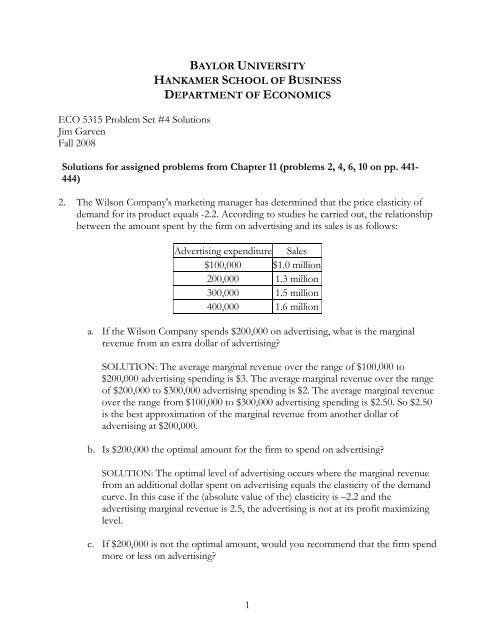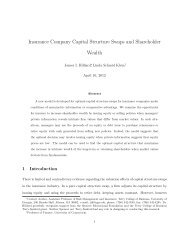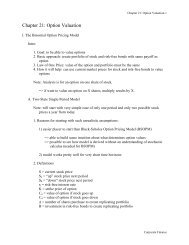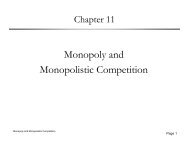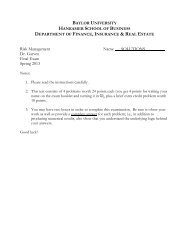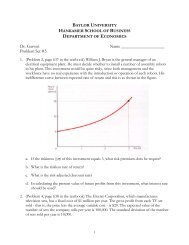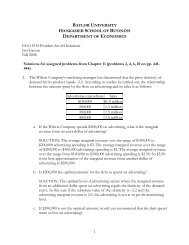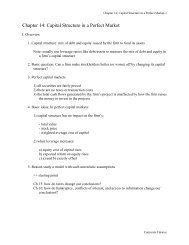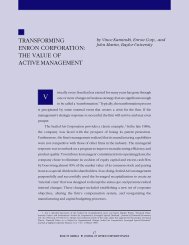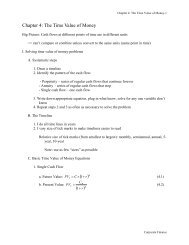Problem Set #4 Solutions - Baylor University
Problem Set #4 Solutions - Baylor University
Problem Set #4 Solutions - Baylor University
You also want an ePaper? Increase the reach of your titles
YUMPU automatically turns print PDFs into web optimized ePapers that Google loves.
ECO 5315 <strong>Problem</strong> <strong>Set</strong> <strong>#4</strong> <strong>Solutions</strong><br />
Jim Garven<br />
Fall 2008<br />
BAYLOR UNIVERSITY<br />
HANKAMER SCHOOL OF BUSINESS<br />
DEPARTMENT OF ECONOMICS<br />
<strong>Solutions</strong> for assigned problems from Chapter 11 (problems 2, 4, 6, 10 on pp. 441-<br />
444)<br />
2. The Wilson Company's marketing manager has determined that the price elasticity of<br />
demand for its product equals -2.2. According to studies he carried out, the relationship<br />
between the amount spent by the firm on advertising and its sales is as follows:<br />
Advertising expenditure Sales<br />
$100,000 $1.0 million<br />
200,000 1.3 million<br />
300,000 1.5 million<br />
400,000 1.6 million<br />
a. If the Wilson Company spends $200,000 on advertising, what is the marginal<br />
revenue from an extra dollar of advertising?<br />
SOLUTION: The average marginal revenue over the range of $100,000 to<br />
$200,000 advertising spending is $3. The average marginal revenue over the range<br />
of $200,000 to $300,000 advertising spending is $2. The average marginal revenue<br />
over the range from $100,000 to $300,000 advertising spending is $2.50. So $2.50<br />
is the best approximation of the marginal revenue from another dollar of<br />
advertising at $200,000.<br />
b. Is $200,000 the optimal amount for the firm to spend on advertising?<br />
SOLUTION: The optimal level of advertising occurs where the marginal revenue<br />
from an additional dollar spent on advertising equals the elasticity of the demand<br />
curve. In this case if the (absolute value of the) elasticity is –2.2 and the<br />
advertising marginal revenue is 2.5, the advertising is not at its profit maximizing<br />
level.<br />
c. If $200,000 is not the optimal amount, would you recommend that the firm spend<br />
more or less on advertising?<br />
1
SOLUTION: The firm should spend more (but not $100,000 more) on<br />
advertising.<br />
4. The Madison Corporation, a monopolist, receives a report from a consulting firm<br />
concluding that the demand function for its product is<br />
Q = 78 - 1.1P + 2.3Y + 0.9A<br />
where Q is the number of units sold, P is the price of its product (in dollars), Y is per<br />
capita income (in thousands of dollars), and A is the firm's advertising expenditure (in<br />
thousands of dollars). The firm's average variable cost function is<br />
AVC = 42 – 8Q + 1.5Q 2<br />
where AVC is average variable cost (in dollars).<br />
a. Can one determine the firm's marginal cost curve?<br />
SOLUTION: From the average variable cost function, we can obtain the total<br />
cost function; i.e., TC = AVC(Q) = 42 – 8Q + 1.5Q 2 = 42Q – 8Q 2 + 1.5Q 3.<br />
Therefore, MC = dTC/dQ = 42 – 16Q + 4.5 Q 2.<br />
b. Can one determine the firm's marginal revenue curve?<br />
SOLUTION: Solving for P in the equation Q = 78 - 1.1P + 2.3Y + 0.9A, we find<br />
that P = (78 – Q + 2.3Y + 0.9A)/1.1. Therefore, TR = PQ = [(78 – Q + 2.3Y +<br />
0.9A)/1.1]Q, and MR = dTR/dQ = (78 – 2Q + 2.3Y + 0.9A)/1.1. We need<br />
information on per capita income and on advertising expenditures to determine<br />
marginal revenue as a function of Q alone.<br />
c. If per capita income is $4,000 and advertising expenditure is $200,000, can one<br />
determine the price and output where marginal revenue equals marginal cost? If<br />
so, what are they?<br />
SOLUTION: <strong>Set</strong> MR = MC. MR = [78 – 2Q + 2.3(4) + 0.9(200)]/1.1 = 242.9 –<br />
1.82Q = 42 – 16Q + 4.5Q 2 = MC ⇒ 4.5Q 2 – 14.18Q – 200.9 = 0.<br />
Since the marginal cost equation is a quadratic (or second degree polynomial)<br />
2<br />
equation of the form ax + bx + c = 0, we can find Q by using the quadratic<br />
2 2<br />
− 14.18 + 14.18 −4(4.5)( −200.9)<br />
− b± b −4ac<br />
formula x = = = Q = 5.29.<br />
2a2(4.5) Therefore, P = (78 – Q + 2.3Y + 0.9A)/1.1 = (78 – 5.29 + 2.3(4) +<br />
0.9($200))/1.1 = 238.1.<br />
2
6. If the Rhine Company ignores the possibility that other firms may enter its market, it<br />
should set a price of $10,000 for its product, which is a power tool. But, if it does so,<br />
other firms will begin to enter the market. During the next two years, it will earn $4<br />
million per year, but in the following two years, it will earn $1 million per year. On the<br />
other hand, if it sets a price of $7,000, it will earn $2.5 million in each of the next four<br />
years, since no entrants will appear.<br />
a. If the interest rate is 10 percent, should the Rhine Company set a price of $7,000<br />
or $10,000? Why? (Consider only the next four years.)<br />
SOLUTION: If a price of $10,000 is chosen, the present value of profits is<br />
$4 million $4 million $1 million $1 million<br />
PV = + + + = $8.376 million,<br />
2<br />
3<br />
4<br />
1.10 1.10 1.10 1.10<br />
whereas if a price of $7,000 is chosen, the present value of profits is<br />
4<br />
$2.5 million /(1.1)<br />
1<br />
t<br />
PV = ∑<br />
t =<br />
4<br />
= $2.5 million × (1− 1/(1.1) )/.1 = $2.5 million (3.1699) = $7.925 million.<br />
Therefore, a price of $10,000 should be chosen, since this price provides a higher<br />
present value of profits.<br />
b. If the interest rate is 8 percent, should the Rhine Company set a price of $7,000<br />
or $10,000? Why? (Consider only the next four years.)<br />
SOLUTION: Since present values are inversely related to discount rates, the<br />
decision to set a price of $10,000 looks even better at 8 percent than it does at 10<br />
percent. At an 8 percent interest rate, the present value of profits is<br />
$4 million $4 million $1 million $1 million<br />
PV = + + + = $8.662 million if<br />
2<br />
3<br />
4<br />
1.08 1.08 1.08 1.08<br />
the price is set at $10,000, whereas if a price of $7,000 is chosen, the present<br />
value of profits is<br />
4<br />
$2.5 million /(1.08)<br />
1<br />
t<br />
PV = ∑<br />
4<br />
= $2.5 million × (1− 1/(1.08) )/.08 = $2.5<br />
t =<br />
million (3.3121) = $8.28 million.<br />
Note that if the interest rate were zero, then the two profit streams would have<br />
equal value. For any positive rate of interest, the $10,000 price yields a higher<br />
present value because it generates the same undiscounted total cash flow and has<br />
more of it sooner than the $7,000 price does.<br />
c. The results in parts a and b pertain to only the next four years. How can the<br />
firm's managers extend the planning horizon?<br />
3
SOLUTION: The firm would need to estimate profits for these additional years<br />
and include them in the present value calculations.<br />
10. The Hassman Company produces two joint products, X and Y. The isocost curve<br />
corresponding to a total cost of $500,000 is<br />
Q = 1, 000 −10Q − 5 Q<br />
Y X<br />
2<br />
X<br />
where QY is the quantity of product Y produced by the firm and Q X is the quantity of<br />
product X produced. The price of product X is 50 times that of product Y.<br />
a. If the optimum output combination lies on this isocost curve, what is the<br />
optimal output of product X?<br />
SOLUTION: Hassman maximizes its profits, given it is spending $500,000 on<br />
inputs, by choosing quantities of X and Y so that the slope of the isorevenue<br />
function equals the slope of the isocost function. The slope of the isorevenue<br />
function is –PX/PY = –50 and the slope of the isocost function is dY/dX = –10<br />
– 10QX. Solving –50 = –10 – 10QX ⇒ QX = 4.<br />
b. What is the optimal output of product Y?<br />
SOLUTION: QY = 1,000 – 10(4) – 5(4) 2 = 880.<br />
c. Can you be sure that the optimum output combination lies on this isocost curve?<br />
Why or why not?<br />
SOLUTION: We have determined the profit maximizing combination of<br />
outputs given the $500,000 expenditure on inputs. There is no certainty that this<br />
is the profit maximizing level of input expenditures.<br />
<strong>Solutions</strong> for assigned problems from Chapter 12 (problems 2, 4, 12 on pp. 55-556<br />
and 559-560.<br />
2. The can industry is composed of two firms. Suppose that the demand curve for cans is<br />
P = 100 - Q<br />
where P is the price (in cents) of a can and Q is the quantity demanded (in millions per<br />
month) of cans. Suppose that the total cost function of each firm is<br />
TC = 2 + 15q<br />
4
where TC is total cost (in tens of thousands of dollars) per month and q is the quantity<br />
produced (in millions) per month by the Firm.<br />
a. What are the price and output if the firms set price equal to marginal cost?<br />
SOLUTION: Since each firm has a constant marginal cost of $.15, the price must<br />
also equal $.15 for price to equal marginal cost. Since marginal cost equals price<br />
equals average variable cost in this case, each firm loses an amount equal to their<br />
fixed costs, $20,000.<br />
b. What are the profit-maximizing price and output if the firms collude and act like a<br />
monopolist?<br />
SOLUTION: If they collude, they will produce where marginal revenue equals<br />
marginal cost. Marginal revenue is given by MR = 100 – 2Q. <strong>Set</strong>ting marginal<br />
revenue equal to marginal cost, we get the joint profit maximizing combined<br />
output is Q = 42.5. Since the firms have constant marginal costs, only one firm<br />
should operate; thereby they avoid the fixed costs of the other firm. Their<br />
combined profits would be π = 57.5(42.5) – [2 + 15(42.5)] = 1,804.25, or<br />
$18,042,500. If they cannot avoid the fixed costs of one of the firms by shutting it<br />
down, their combined profits would be $18,022,500.<br />
c. Do the firms make a higher combined profit if they collude than if they set price<br />
equal to marginal cost? If so, how much higher is their combined profit?<br />
SOLUTION: Since they lose $40,000 if they compete and earn $18,022,500 if<br />
they collude, they earn $18,062,500 more if they collude than if they compete.<br />
4. James Pizzo is president of a firm that is the price leader in the industry; that is, it sets the<br />
price and the other firms sell all they want at that price. In other words, the other firms<br />
act as perfect competitors. The demand curve for the industry’s product is P = 300 - Q,<br />
where P is the price of the product and Q is the total quantity demanded. The total<br />
amount supplied by the other firms is equal to Q r , where Q r = 49P. (P is measured in<br />
dollars per barrel; Q, Qr , and Qb are measured in millions of barrels per week.)<br />
a. If Pizzo’s firm’s marginal cost curve is 2.96 Q b where Q b is the output of his<br />
firm, at what output level should he operate to maximize profit?<br />
SOLUTION: The residual demand faced by Pizzo is Q - Qr = 300 – P – 49P =<br />
300 – 50P, which can be written as P = 6 – 0.02Qb. <strong>Set</strong>ting his marginal revenue<br />
equal to his marginal cost, 6 – 0.04Qb = 2.96Qb ⇒ Qb = 2, Pizzo determines that<br />
the profit maximizing quantity is 2.<br />
5
. What price should he charge?<br />
SOLUTION: P = 6 – 0.02(2) = $5.96.<br />
c. How much does the industry as a whole produce at this price?<br />
SOLUTION: Q = 300 – P = 294.04, Q r = 49(596) = 292.04.<br />
d. Is Pizzo’s firm the dominant firm in the industry?<br />
SOLUTION: No. The elasticity of Pizzo’s residual demand at his chosen level of<br />
output is nearly 150. Notice that his marginal cost is $5.92 and yet his market<br />
power only allows him to charge a price of $5.96. He produces less than 1<br />
percent of the industry’s output.<br />
12. Steve Win has purchased land (an old landfill-from rags to riches) from the city of<br />
Atlantic City in the Marina section of the city. There are stories of a new casino building<br />
boom in Atlantic City (MGeeM is also talking about entering and Gump is opening his<br />
fourth casino). Some talk is circulating that Win will subdivide his new land purchase<br />
and perhaps three casinos will be built on the site.<br />
Suppose that Win subdivides his land into two parcels. He builds on one site and sells<br />
the other to another gambling entrepreneur. Win estimates that the demand for<br />
gambling in the Marina area of Atlantic City (After accounting for the presence of two<br />
existing casinos in the Marina and adjusting for the rest of the casinos in Atlantic City)<br />
to be<br />
P = 750 – 5Q<br />
where P is the price associated with gambling and Q is the quantity of gambling (think<br />
of P as the average amount that a typical patron will net the casino, an amount paid for<br />
the entertainment of gambling, and Q as the number of gamblers).<br />
Win, of course, does not sell the other parcel until his casino is built (or is significantly<br />
far along); thus, he has a first-mover advantage.<br />
Win’s total cost (TCw) of producing gambling is<br />
TC = 20 + 40 Q + 15.5Q<br />
W W<br />
2<br />
W<br />
where W<br />
Q is the number of gamblers in Win’s casino and the total cost (TCR) of<br />
producing gambling for Win’s rival is<br />
6
TC = 10 + 50 Q + 20 Q<br />
R R<br />
2<br />
R<br />
where Q R is the number of gamblers in the rival’s casino and<br />
Q W + Q R = Q<br />
Would Atlantic City have done better to sell the land as two separate parcels rather than<br />
as a single parcel to Win (given that Win was going to subdivide, Win and his rival could<br />
not collude, and Win did not have the ability to produce as a monopolist)? You may<br />
assume that Win and his rival could have been Cournot duopolists. If Atlantic City<br />
could do better, show why and by how much? Carry all calculations to the thousandths<br />
decimal point.<br />
SOLUTION: As I pointed out in my email/blog entry from November 16, we assume<br />
that the objective for Atlantic City is to maximize the quantity of gambling. The answer<br />
to this question involves a comparison of the outcomes that occur under the Cournot<br />
equilibrium compared with the Stackelberg equilibrium (where Win is the leader and the<br />
rival is the follower). The two-parcel setup is suggested in order to motivate a Cournot<br />
solution (where Win and Win’s rival make simultaneous decisions), whereas the<br />
constrained one-parcel setup is presented in order to motivate a Stackelberg solution.<br />
Therefore, suppose that Win and Win’s rival are a Cournot duopoly. Since<br />
P = 750 −5Q ⇒ P = 750 −5QW − 5 QR.<br />
Therefore, total revenue for Win ( TR W ) is:<br />
TRW = (750 −5QW − 5 QR) QW = 750 QW 2<br />
−5QW − 5QWQR;<br />
thus<br />
MRW = 750 −10QW − 5QR = 40 + 31QW = MCW ⇒710 −41QW − 5QR = 0 ⇒<br />
Q = 17.317 −.122 Q , which is Win’s reaction function.<br />
W R<br />
Similarly, total revenue for Win’s ( TR R ) is:<br />
TRR = (750 −5QW − 5 QR) QR = 750Q R<br />
2<br />
−5QR − 5QWQR;<br />
thus<br />
MRW = 750 −10QR − 5QW = 50 + 40 QR = MC R ⇒700 −50QR − 5QW = 0 ⇒<br />
Q = 14 −.1 Q , which is Win’s rival’s reaction function.<br />
R W<br />
Next, substitute the right-hand side of Win’s rival’s reaction function into Win’s reaction<br />
function: QW = 17.317 −.122(14 −.1 QW ) ⇒ QW = 15.8 ⇒ QR<br />
= 14 − .1(15.8) = 12.42.<br />
Thus, Q = QW + QR = 15.8 + 14.22 = 28.22 ⇒ P = 750 − 5(28.22) = $608.90.<br />
Furthermore, π W<br />
2<br />
= 608.90(15.8) −20 −40(15.8) − 15.5(15.8 ) = $5,099.20, and<br />
2<br />
π = 608.90(12.42) −10−50(12.42) − 20(12.42 ) =<br />
$3,846.91.<br />
R<br />
7
Now, suppose that Win is the leader and Win’s rival is the follower. We know that<br />
TRW = 750 QW 2<br />
−5QW − 5 QWQR; substituting the right-hand side of Win’s rival’s<br />
reaction function, we obtain TRW = 750QW 2<br />
−5QW −5 QW(14 − .1 QW<br />
) =<br />
680 QW 2<br />
−4.5QW ⇒ MRW = 680 − 9QW = 40 + 31QW = MCW ⇒ QW<br />
= 16. Therefore,<br />
Q R = 14 − .1(16) = 12.4 ⇒ Q = QW + QR = 16 + 12.4 = 28.4 ⇒ P = 750 − 5(28.4) =<br />
$608. Furthermore, π W<br />
2<br />
= 608(16) −20−40(16) − 15.5(16 ) = $5,100, and<br />
2<br />
π = 608(12.4) −10−50(12.4) − 20(12.4 ) = $3,834.<br />
R<br />
Similarly, total revenue for Win’s ( TR R ) is:<br />
TRR = (750 −5QW − 5 QR) QR = 750Q R<br />
2<br />
−5QR − 5QWQR;<br />
thus<br />
MRW = 750 −10QR − 5QW = 50 + 40 QR = MC R ⇒700 −50QR − 5QW = 0 ⇒<br />
Q = 14 −.1 Q , which is Win’s rival’s reaction function.<br />
R W<br />
Next, substitute the right-hand side of Win’s rival’s reaction function into Win’s reaction<br />
function: QW = 17.317 −.122(14 −.1 QW ) ⇒ QW = 15.8 ⇒ QR<br />
= 14 − .1(15.8) = 12.42.<br />
Thus, Q = QW + QR = 15.8 + 14.22 = 28.22 ⇒ P = 750 − 5(28.22) = $608.90.<br />
Furthermore, π W<br />
2<br />
= 608.90(15.8) −20 −40(15.8) − 15.5(15.8 ) = $5,099.20, and<br />
2<br />
π = 608.90(12.42) −10−50(12.42) − 20(12.42 ) = $3,846.91.<br />
R<br />
In summary, the price-quantity pair in the Cournot equilibrium is ($608.90, 28.22),<br />
whereas the price-quantity pair in the Stackelberg equilibrium is ($608, 28.4). If Atlantic<br />
City’s objective is to structure the deal so as to maximize the quantity of gambling, then<br />
it should sell the land as single parcel, with the quid pro quo that Win subdivide the parcel<br />
and sell it to a rival for the same price that would have obtained had the city sold the<br />
land as two separate parcels (to Win and Win’s rival) in the first place.<br />
8


